



Target audience
| LOCATION | GROUP | LANGUAGE | DATE | TIME (EST) | GROUP COMPOSITION | NUMBER OF PARTICIPANTS |
|---|---|---|---|---|---|---|
| Peel Region Ontario | 1 | English | Dec. 1 | 6:00-8:00 pm | Exhibiting Riskier Behaviours | 8 |
| GMA | 2 | French | Dec. 2 | 6:00-8:00 pm | Exhibiting Riskier Behaviours | 8 |
| Greater Vancouver Area | 3 | English | Dec. 3 | 8:00-10:00 pm | Young Adults (aged 18-24) | 7 |
| Major Centres Ontario | 4 | English | Dec. 7 | 6:00-8:00 pm | People with Elderly/Vulnerable Parents | 8 |
| Major Centres Alberta (Calgary & Edmonton) | 5 | English | Dec. 8 | 8:00-10:00 pm | Young Adults (aged 18-24) | 7 |
| The Outaouais Region (Gatineau and the MRC des Collines-de-l’Outaouais) | 6 | French | Dec. 9 | 6:00-8:00 pm | General Population | 7 |
| Major Centres Atlantic Canada | 7 | English | Dec. 10 | 5:00-7:00 pm | Parents of School Age Children (JK-Gr.12) | 8 |
| Winnipeg | 8 | English | Dec. 15 | 7:00-9:00 pm | People with Elderly/Vulnerable Parents | 5 |
| Northern Ontario | 9 | English | Dec. 16 | 6:00-8:00 pm | Indigenous | 6 |
| Iqaluit | 10 | English | Dec. 17 | 6:00-8:00 pm | General population | 7 |
| Total number of participants | 77 | |||||

The figure above shows a social media ad, featuring the Government of Canada social media handle at the top of the ad (including a small Government of Canada logo, a blue checkmark and @canada.ca). The main head line (at the top of the ad) reads: “Considering a trip this holiday season? Know the facts first. Visit travel.gc.ca/travel-covid to stay informed on the latest travel rules and restrictions.” The main image in the ad features a navy blue background with a graphic image (on the right) of a woman looking straight into the camera with a man and child cooking together in the background, all of which is framed by a maple leaf. On the left hand side, the main headline reads “Should we go away for winter break?” with a subtext below reading “Know the facts before deciding to travel.” Below the main image, there is a light gray banner with the website travel.gc.ca/travel-covid in navy blue font and the Canada Wordmark on the right hand side. Below the main image of the ad, black text reads “COVID-19: Travel, quarantine and borders” with subtext reading “Learn more at travel.gc.ca/travel-covid” against a white background. At the very bottom of the ad, there are small logos indicating an option to comment, between, like, and share the ad.

The figure above shows a social media ad, featuring the Government of Canada social media handle at the top of the ad (including a small Government of Canada logo, a blue checkmark and @canada.ca). The main head line (at the top of the ad) reads: “Considering a trip this holiday season? Know the facts first. Visit travel.gc.ca/travel-covid to stay informed on the latest travel rules and restrictions.” The main image in the ad features a navy blue background with a graphic image (on the right) of a elderly woman looking straight into the camera with an elderly man making coffee in the background, all of which is framed by a maple leaf. On the left hand side, the main headline reads “Should we go see family for the holidays?” with a subtext below reading “Know the facts before deciding to travel.” Below the main image, there is a light gray banner with the website travel.gc.ca/travel-covid in navy blue font and the Canada Wordmark on the right hand side. Below the main image of the ad, black text reads “COVID-19: Travel, quarantine and borders” with subtext reading “Learn more at travel.gc.ca/travel-covid” against a white background. At the very bottom of the ad, there are small logos indicating an option to comment, between, like, and share the ad.
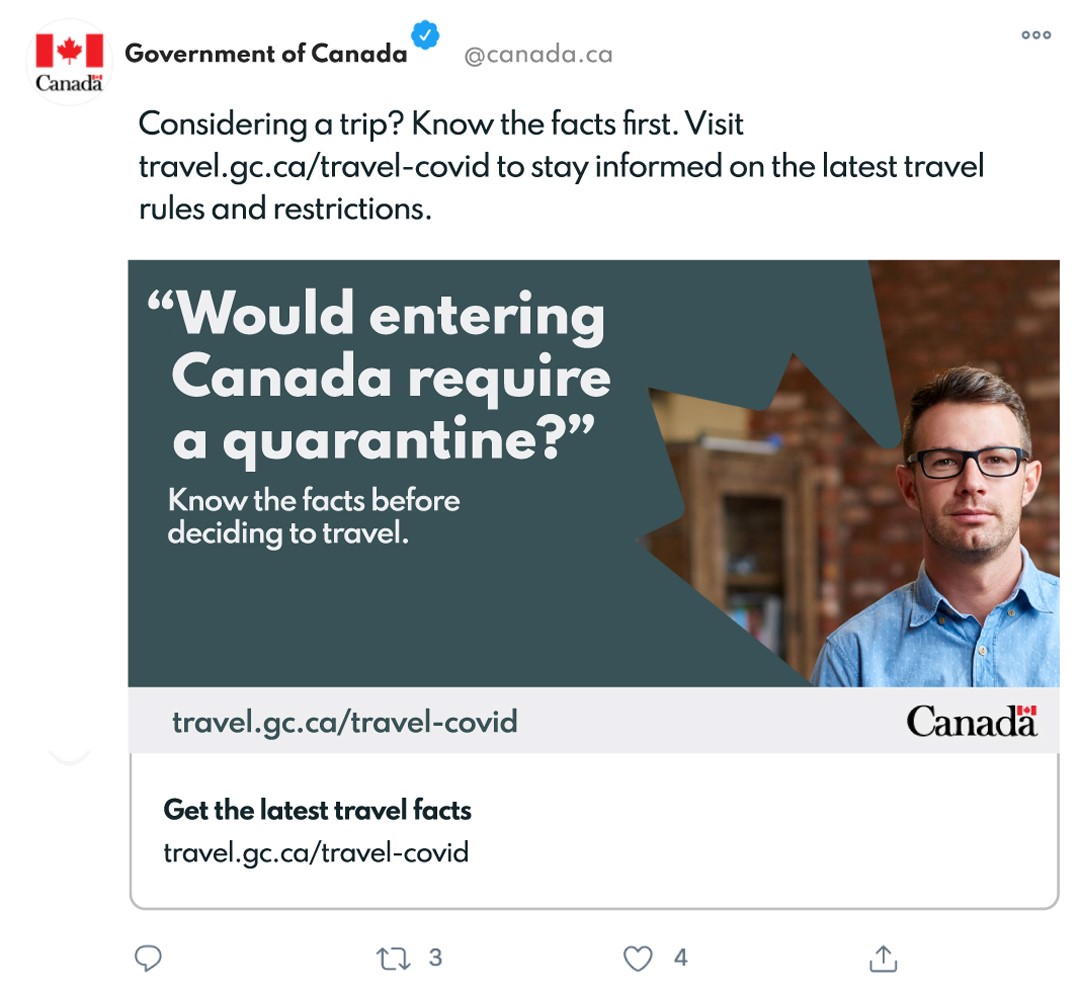
The figure above shows a social media ad, featuring the Government of Canada social media handle at the top of the ad (including a small Government of Canada logo, a blue checkmark and @canada.ca). The main head line (at the top of the ad) reads: “Considering a trip? Know the facts first. Visit travel.gc.ca/travel-covid to stay informed on the latest travel rules and restrictions.” The main image in the ad features a dark green background with a graphic image (on the right) of a man looking straight at the camera with a brick wall behind him. On the left hand side, the main headline reads “Would entering Canada require a quarantine?” with a subtext below reading “Know the facts before deciding to travel.” Below the main image, there is a light gray banner with the website travel.gc.ca/travel-covid in dark green font and the Canada Wordmark on the right hand side. Below the main image of the ad, black text reads “Get the latest travel facts” with subtext reading “travel.gc.ca/travel-covid” against a white background. At the very bottom of the ad, there are small logos indicating an option to comment, between, like, and share the ad.
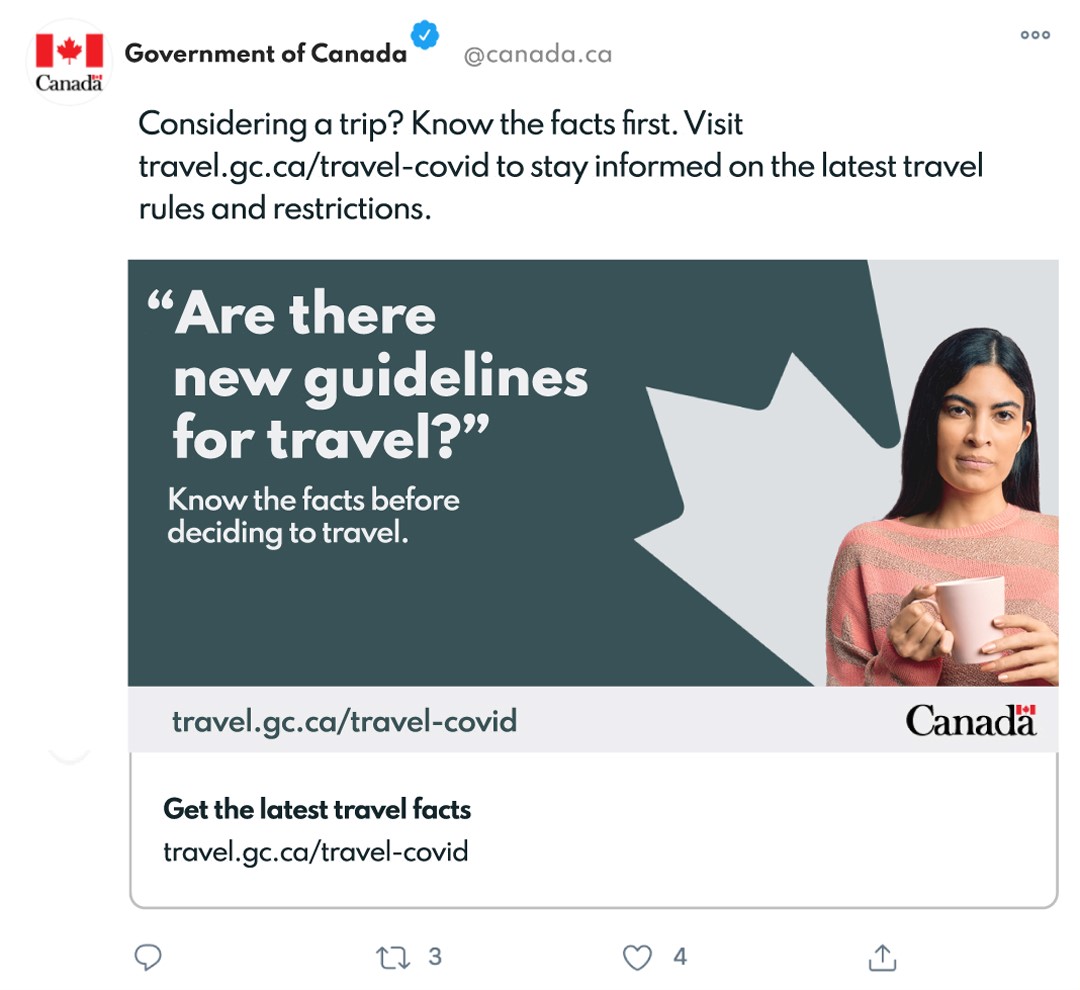
The figure above features a social media ad sponsored by the Government of Canada. The social media handle at the top of the ad includes a small Government of Canada logo, a blue verified badge and the handle @canada.ca. The main text for the post (at the top of the ad) reads: “Considering a trip? Know the facts first. Visit travel.gc.ca/travel-covid to stay informed on the latest travel rules and restrictions.” The main image of the ad features a dark green background with an image (on the right) of a woman holding a mug set against a light green background, which is framed by a maple leaf graphic. On the left hand side, the main headline reads “Are there new guidelines for travel?” with a subtext below reading “Know the facts before deciding to travel.” Below the main image, there is a light gray banner with the website “travel.gc.ca/travel-covid” in dark green font and the Canada Wordmark on the right hand side. Below the main image of the ad, black text reads “Get the latest travel facts” with subtext reading “travel.gc.ca/travel-covid” against a white background. At the very bottom of the ad, there are small logos indicating an option to reply, retweet, like, and share the ad.

The figure above shows a social media ad, featuring the Government of Canada social media handle at the top of the ad (including a small Government of Canada logo, a blue checkmark and @canada.ca). The main head line (at the top of the ad) reads: “Considering a trip? Know the facts first. Visit travel.gc.ca/travel-covid to stay informed on the latest travel rules and restrictions.” The main image in the ad features a dark green background with a graphic image (on the right) of a woman holding a mug set against a lighter green background, which is framed by a maple leaf. On the left hand side, the main headline reads “What are the rules around travel?” with a subtext below reading “Know the facts before deciding to travel.” Below the main image, there is a light gray banner with the website travel.gc.ca/travel-covid in dark green font and the Canada Wordmark on the right hand side. Below the main image of the ad, black text reads “Get the latest travel facts” with subtext reading “travel.gc.ca/travel-covid” against a white background. At the very bottom of the ad, there are small logos indicating an option to comment, between, like, and share the ad.
The above video begins with scene of a woman sitting in her car. She puts on a non-medical mask and then enters a store. The next scene shows multiple young people gathered in a living room, laughing and sharing drinks and food. The scene then shifts to a man asleep on an airplane with his mouth open. Accompanying voiceover for these three scenes says ”Every time you wear a mask, remember, it is so one day we can all go back to doing this, and this.” The next set of three scenes starts with a man washing his hands with soap and water and a young woman brings him a towel, followed by a birds eye view of people raising a toast and the last scene shows an older couple dancing together in a small group. The voiceover accompanying these scenes says “Every time you wash your hands, remember, that eventually, it will all be worth it for them, and them.” The final set of scenes follows a series of clips including a young man on a video call with his friends, an outdoor wedding, a DJ playing for a large crowd and finally a scene of a hockey game where two friends are cheering in the stands together. Accompanying voiceover says “Every time you hang out here, remember that at some point, we’ll all be able to get together here, here and here.” A blue screen with white text then appears that reads “Keep following COVID-19 public health measures.” with the URL ‘canada.ca/coronavirus’ and phone number ‘1-833-784-4397’ written at the bottom of the screen. The voiceover then says “Protect yourself and others from COVID-19. A message from the Government of Canada.” The ad ends on a black screen with the Government of Canada wordmark.
The above video begins with a scene of a young woman entering a party with purple glitter on her and hugging a young man. By hugging, the young woman passes the glitter onto the young man’s sweater. The scene cuts to the man eating from a bowl of chips with purple glitter on them and the young woman holds his hand. The next scene cuts to the same young man, now at home in his kitchen. He has glitter on his clothes and it is also all over his kitchen, including on the counter, fridge, and cupboards. There is a box of cookies on the counter that he is eating from, also covered in glitter. The young man’s mother walks in, wearing a housecoat. She comes over and eats a cookie from the glitter-covered box. A male voiceover says, “Is going to a party really worth it?” The final scene pan to the mother, eating the cookie. She, too, now has glitter around her mouth and reaches for another cookie from the glittery box, next to a milk cup with the same glitter on it. An overlay of text on the screen as well as a female voiceover says, “Putting yourself at risk puts everyone at risk.” A light pink screen with darker pink font then appears, along with audio, reading “Help limit the spread of COVID-19.” The word COVID-19 on screen is in yellow and has purple glitter behind it. The ad ends on a black screen and the Government of Canada wordmark is shown.
The above video features Dr. Theresa Tam sitting at a desk with a mask and hand sanitizer nearby and a Canada flag in the background. Dr. Tam’s full title of Chief Public Health Officer of Canada is shown on the left hand side of the screen throughout the video. Dr. Theresa Tam says the following: “The COVID-19 pandemic in Canada is serious. We must continue to practice all public health measures. Follow local guidelines for gatherings, maintain physical distancing, wash your hands, wear a mask and download the COVID Alert App. If you have symptoms, even mild ones, stay home. Protect yourself and others. We’ve come too far to stop now.” Near the end of the ad, the following white text is overlaid at the bottom of the screen: ‘Learn more at Canada.ca/coronavirus or 1-833-784-4397.’ The ad ends on a black screen and the Government of Canada wordmark is shown with accompanying voiceover: “A message from the Government of Canada.”

This infographic features a white background with a graphic of blue waves across the bottom third of the page. On the top left, the version date “Updated December 1, 2020” in written grey font underlined by a dark blue waved line. Towards the top third of the infographic, text on the left reads, “97 long-term drinking water advisories lifted since November 2015” in grey font, with the number “97” in large font and the word “lifted’” in blue font. To the right, text reads “59 long-term drinking water advisories in effect in 41 communities” where the numbers are in large font and the words “in effect in” is written in blue text. For the bottom two-thirds of the infographic, there is a large line graph. The vertical axis is labelled with water advisories (ranging from 0 to 110) and the horizontal axis is labelled with years (ranging from 2016 to 2021). In the graph, a red line tracks downwards, from left to right. At the top left of the graph is (around 2015 horizontally) the number 105 in red font a white circle. On the bottom right of the graph (around 2021 horizontally) is the number 59 in a red pinpoint icon. In the bottom left hand side of the graph, a legend depicts that the red pinpoint icon is the “current number of long-term drinking water advisories in effect on public systems on reserves” and that each point on the line graph is “past long-term drinking water advisories.”
| GROUP | DATE | TIME (EST) | TIME (LOCAL) | LOCATION | COMPOSITION | MODER-ATOR |
|---|---|---|---|---|---|---|
| 1 | Tues., Dec 1 | 6:00-8:00 | 6:00-8:00 (EST) | Ontario – Peel Region | People Exhibiting Riskier Behaviours, All Ages | DN |
| 3 | Thurs., Dec 3 | 8:00-10:00 | 5:00-7:00 (PST) | Greater Vancouver Area | Young Adults, Aged 18-24 | TBW |
| 4 | Mon., Dec. 7 | 6:00-8:00 | 6:00-8:00 (EST) | Ontario – Major Centres | Persons with Elderly/Vulnerable Parents | DN |
| 5 | Tues., Dec. 8 | 8:00-10:00 | 6:00-8:00 (MST) | Alberta – Calgary and Edmonton | Young Adults, Aged 18-24 | TBW |
| 7 | Thurs., Dec 10 | 5:00-7:00 | 6:00-8:00 (AST) 6:30-8:30 (NST) | Atlantic Canada – Major Centres | Parents of School Age Children, JK to Gr. 12 | DN |
| 8 | Tues., Dec. 15 | 7:00-9:00 | 6:00-8:00 (CST) | Winnipeg | Persons with Elderly/Vulnerable Parents | TBW |
| 9 | Wed., Dec. 16 | 6:00-8:00 | 6:00-8:00 (EST) | Northern Ontario | Indigenous Peoples | DN |
| 10 | Thurs., Dec. 17 | 6:00-8:00 | 6:00-8:00 (EST) | Iqaluit | Gen Pop | DN |
| LOCATION | CITIES | |
|---|---|---|
| Ontario – Peel Region | Cities could include (but are not limited to): Brampton, Mississauga, Caledon MAX OF 3 PARTICIPANTS FROM BRAMPTON 3 FROM MISSISSAUGA. ENSURE A GOOD MIX OF CITIES ACROSS THE REGION. |
CONTINUE - GROUP 1 |
| Greater Vancouver Area | Cities could include (but are not limited to): Vancouver, West and North Vancouver, Surrey, Burnaby, Richmond, Coquitlam, Port Coquitlam, Delta, Maple Ridge, New Westminster, Port Moody, Langley, Maple Ridge, White Rock ENSURE A GOOD MIX OF CITIES ACROSS THE REGION. NO MORE THAN TWO PER CITY. |
CONTINUE - GROUP 3 |
| Ontario – Major Centres | Cities could include (but are not limited to): Toronto, Ottawa, Mississauga, Brampton, Hamilton ENSURE A GOOD MIX OF CITIES ACROSS THE REGION. NO MORE THAN TWO PER CITY. |
CONTINUE - GROUP 4 |
| Alberta – Calgary and Edmonton | Calgary and Edmonton 4 PARTICIPANTS FROM EACH CITY. PARTICIPANTS SHOULD RESIDE IN THE ABOVE-NOTED CENTERS PROPER. |
CONTINUE GROUP 5 |
| Atlantic Canada – Major Centres | Cities could include (but are not limited to):
Nova Scotia: Halifax-Dartmouth, Cape Breton
Newfoundland and Labrador: St. John’s,
New Brunswick: Moncton, Saint John, Fredericton
PEI: Charlottetown, Summerside
ENSURE A GOOD MIX OF CITIES ACROSS THE REGIONS. AIM FOR 2 PARTICIPANTS FROM EACH PROVINCE. NO MORE THAN TWO PER CITY. |
CONTINUE - GROUP 7 |
| Winnipeg | Winnipeg PARTICIPANTS SHOULD RESIDE IN THE ABOVE-NOTED CENTERS PROPER. |
CONTINUE - GROUP 8 |
| Northern Ontario | Cities could include (but are not limited to): Sudbury, Thunder Bay, Sault Ste. Marie, North Bay, Timmins, Kenora, Elliot Lake ENSURE A GOOD MIX OF CITIES ACROSS THE REGION. INCLUDE THOSE RESIDING IN LARGER AND SMALLER COMMUNITIES. |
CONTINUE - GROUP 9 |
| Iqaluit | Iqaluit
PARTICIPANTS SHOULD RESIDE IN THE ABOVE-NOTED CENTER PROPER. |
CONTINUE - GROUP 10 |
| Other | THANK AND END | |
| VOLUNTEERED Prefer not to answer | - | THANK AND END |
| Less than two years | THANK AND END |
|---|---|
| Two years or more | CONTINUE |
| Don’t know/Prefer not to answer | THANK AND END |
| 75-79 years old | CONTINUE IF ‘YES’ TO ANY. ENSURE A GOOD MIX BY AGE OF PARENT. |
|---|---|
| 80-84 years old | |
| 85-89 years old | |
| 90 years old or older | |
| Don’t know/Prefer not to answer | |
| None of the above | THANK AND END |
| VOLUNTEERED Prefer not to answer |
| Child | Grade |
|---|---|
| 1 | |
| 2 | |
| 3 | |
| 4 | |
| 5 |
| Yes | CONTINUE ENSURE A GOOD MIX OF DIFFERENT INDIGENOUS GROUPS. |
|---|---|
| No | THANK AND END |
| Don’t know/Prefer not to answer |
| Under 18 years of age | IF POSSIBLE, ASK FOR SOMEONE OVER 18 AND REINTRODUCE. OTHERWISE THANK AND END. |
|---|---|
| 18-24 | IF GREATER VANCOUVER AREA = GROUP 3 IF CALGARY/EDMONTON = GROUP 5 ALL OTHER LOCATIONS, CONTINUE |
| 25-34 | IF GREATER VANCOUVER AREA OR CALGARY/EDMONTON = THANK AND END ALL OTHER LOCATIONS, CONTINUE |
| 35-44 | |
| 45-54 | |
| 55+ | |
| VOLUNTEERED Prefer not to answer | THANK AND END |
| GROUPE | DATE | HEURE (DE L’EST) | LIEU | COMPOSITION DU GROUPE | MODÉRATEUR |
|---|---|---|---|---|---|
| 2 | 2 décembre | 18 h-20 h | Grande région de Montréal – y compris Montréal même | Personnes ayant des comportements plus à risque, tous âges | M. Proulx |
| 6 | 9 décembre | 18 h-20 h | Région de l’Outaouais – Gatineau et MRC des Collines-de l’Outaouais | Population générale | M. Proulx |
| LIEU | VILLES | |
|---|---|---|
| Grande région de Montréal (GRM) – y compris Montréal même | Les villes de la GRM peuvent notamment comprendre : Montréal, Laval, Longueuil, Terrebonne, Brossard, Saint-Jérôme, Blainville, Mirabel, Dollard-des-Ormeaux PAS PLUS DE TROIS PARTICIPANTS DE LA VILLE DE MONTRÉAL. ASSURER UNE BONNE REPRÉSENTATION DES VILLES DANS CHAQUE LIEU. |
CONTINUER - GROUPE 2 |
| Région de l’Outaouais – Gatineau et MRC des Collines-de-l’Outaouais | Ces villes peuvent notamment comprendre : Gatineau, Les Collines-de-l’Outaouais : Val-des-Monts, Cantley, Le Pêche, Chelsea, Pontiac, L'Ange-Gardien, Notre-Dame-de-la-Salette ASSURER UNE BONNE REPRÉSENTATION DES VILLES DANS CHAQUE LIEU. |
CONTINUER - GROUPE 7 |
| Autre lieu | - | REMERCIER ET CONCLURE |
| RÉPONSE SPONTANÉE Préfère ne pas répondre | - | REMERCIER ET CONCLURE |
| Moins de deux ans | REMERCIER ET CONCLURE |
|---|---|
| Deux ans ou plus | CONTINUER |
| Ne sais pas/Préfère ne pas répondre | REMERCIER ET CONCLURE |
| Moins de 18 ans | SI POSSIBLE, DEMANDER À PARLER À UNE PERSONNE DE 18 ANS OU PLUS ET REFAIRE L’INTRODUCTION. SINON, REMERCIER ET CONCLURE. |
|---|---|
| 18 à 24 | CONTINUER ASSURER UNE BONNE REPRÉSENTATION DES ÂGES DANS CHAQUE GROUPE. |
| 25 à 34 | |
| 35 à 44 | |
| 45 à 54 | |
| 55 ans ou plus | |
| RÉPONSE SPONTANÉE Préfère ne pas répondre | REMERCIER ET CONCLURE |
The above video begins with scene of a woman sitting in her car. She puts on a non-medical mask and then enters a store. The next scene shows multiple young people gathered in a living room, laughing and sharing drinks and food. The scene then shifts to a man asleep on an airplane with his mouth open. Accompanying voiceover for these three scenes says ”Every time you wear a mask, remember, it is so one day we can all go back to doing this, and this.” The next set of three scenes starts with a man washing his hands with soap and water and a young woman brings him a towel, followed by a birds eye view of people raising a toast and the last scene shows an older couple dancing together in a small group. The voiceover accompanying these scenes says “Every time you wash your hands, remember, that eventually, it will all be worth it for them, and them.” The final set of scenes follows a series of clips including a young man on a video call with his friends, an outdoor wedding, a DJ playing for a large crowd and finally a scene of a hockey game where two friends are cheering in the stands together. Accompanying voiceover says “Every time you hang out here, remember that at some point, we’ll all be able to get together here, here and here.” A blue screen with white text then appears that reads “Keep following COVID-19 public health measures.” with the URL ‘canada.ca/coronavirus’ and phone number ‘1-833-784-4397’ written at the bottom of the screen. The voiceover then says “Protect yourself and others from COVID-19. A message from the Government of Canada.” The ad ends on a black screen with the Government of Canada wordmark.
3 Glitter.mp4The above video begins with a scene of a young woman entering a party with purple glitter on her and hugging a young man. By hugging, the young woman passes the glitter onto the young man’s sweater. The scene cuts to the man eating from a bowl of chips with purple glitter on them and the young woman holds his hand. The next scene cuts to the same young man, now at home in his kitchen. He has glitter on his clothes and it is also all over his kitchen, including on the counter, fridge, and cupboards. There is a box of cookies on the counter that he is eating from, also covered in glitter. The young man’s mother walks in, wearing a housecoat. She comes over and eats a cookie from the glitter-covered box. A male voiceover says, “Is going to a party really worth it?” The final scene pan to the mother, eating the cookie. She, too, now has glitter around her mouth and reaches for another cookie from the glittery box, next to a milk cup with the same glitter on it. An overlay of text on the screen as well as a female voiceover says, “Putting yourself at risk puts everyone at risk.” A light pink screen with darker pink font then appears, along with audio, reading “Help limit the spread of COVID-19.” The word COVID-19 on screen is in yellow and has purple glitter behind it. The ad ends on a black screen and the Government of Canada wordmark is shown.
2 Dr. Theresa TamThe above video features Dr. Theresa Tam sitting at a desk with a mask and hand sanitizer nearby and a Canada flag in the background. Dr. Tam’s full title of Chief Public Health Officer of Canada is shown on the left hand side of the screen throughout the video. Dr. Theresa Tam says the following: “The COVID-19 pandemic in Canada is serious. We must continue to practice all public health measures. Follow local guidelines for gatherings, maintain physical distancing, wash your hands, wear a mask and download the COVID Alert App. If you have symptoms, even mild ones, stay home. Protect yourself and others. We’ve come too far to stop now.” Near the end of the ad, the following white text is overlaid at the bottom of the screen: ‘Learn more at Canada.ca/coronavirus or 1-833-784-4397.’ The ad ends on a black screen and the Government of Canada wordmark is shown with accompanying voiceover: “A message from the Government of Canada.”
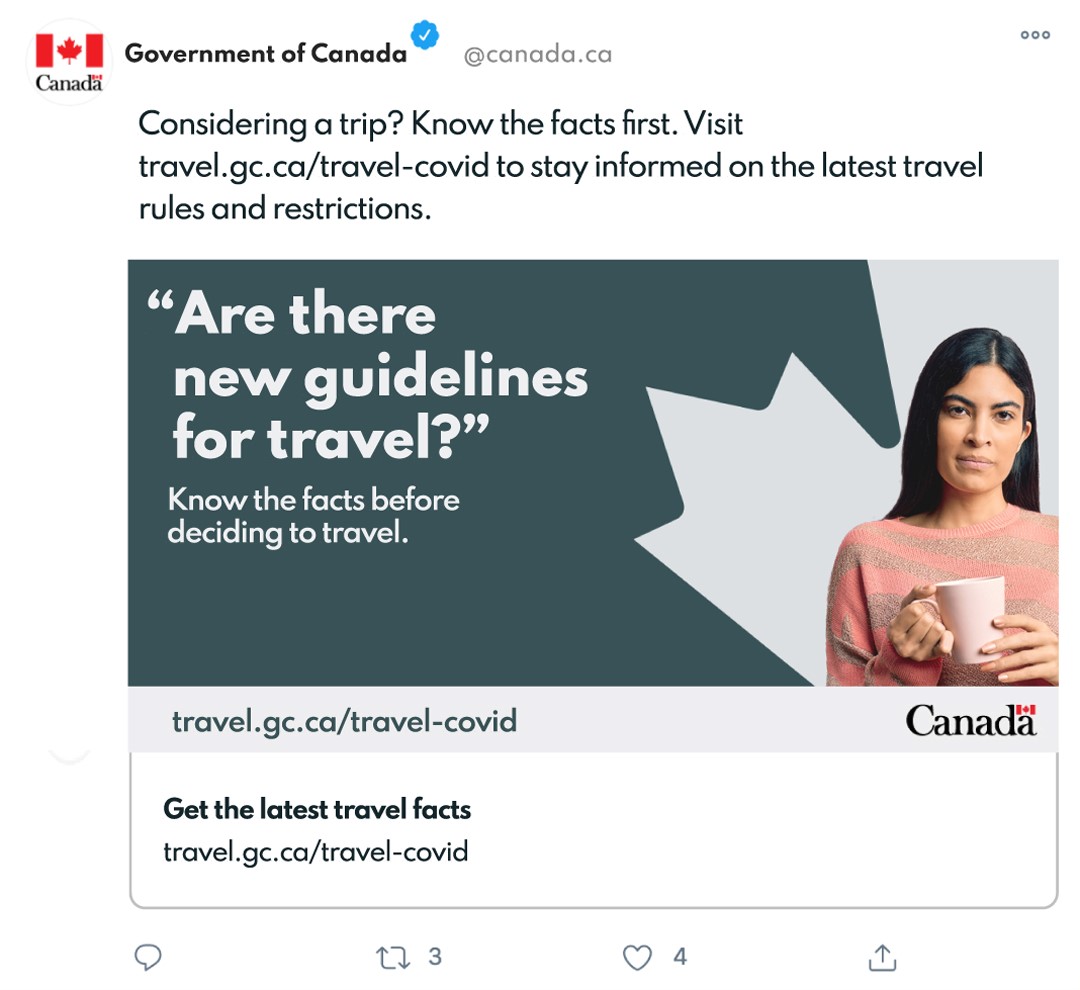
The figure above features a social media ad sponsored by the Government of Canada. The social media handle at the top of the ad includes a small Government of Canada logo, a blue verified badge and the handle @canada.ca. The main text for the post (at the top of the ad) reads: “Considering a trip? Know the facts first. Visit travel.gc.ca/travel-covid to stay informed on the latest travel rules and restrictions.” The main image of the ad features a dark green background with an image (on the right) of a woman holding a mug set against a light green background, which is framed by a maple leaf graphic. On the left hand side, the main headline reads “Are there new guidelines for travel?” with a subtext below reading “Know the facts before deciding to travel.” Below the main image, there is a light gray banner with the website “travel.gc.ca/travel-covid” in dark green font and the Canada Wordmark on the right hand side. Below the main image of the ad, black text reads “Get the latest travel facts” with subtext reading “travel.gc.ca/travel-covid” against a white background. At the very bottom of the ad, there are small logos indicating an option to reply, retweet, like, and share the ad.

The figure above shows a social media ad, featuring the Government of Canada social media handle at the top of the ad (including a small Government of Canada logo, a blue checkmark and @canada.ca). The main head line (at the top of the ad) reads: “Considering a trip? Know the facts first. Visit travel.gc.ca/travel-covid to stay informed on the latest travel rules and restrictions.” The main image in the ad features a dark green background with a graphic image (on the right) of a woman holding a mug set against a lighter green background, which is framed by a maple leaf. On the left hand side, the main headline reads “What are the rules around travel?” with a subtext below reading “Know the facts before deciding to travel.” Below the main image, there is a light gray banner with the website travel.gc.ca/travel-covid in dark green font and the Canada Wordmark on the right hand side. Below the main image of the ad, black text reads “Get the latest travel facts” with subtext reading “travel.gc.ca/travel-covid” against a white background. At the very bottom of the ad, there are small logos indicating an option to comment, between, like, and share the ad.
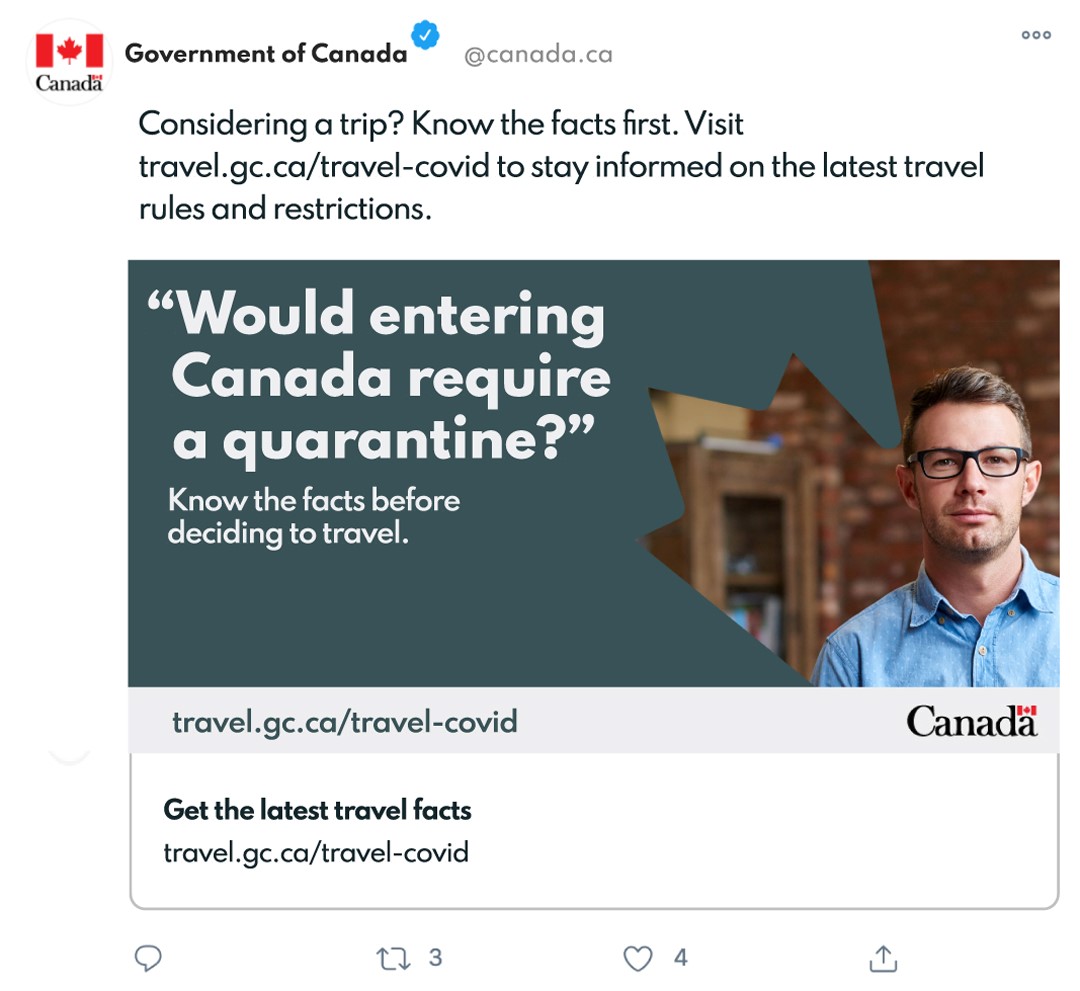
The figure above shows a social media ad, featuring the Government of Canada social media handle at the top of the ad (including a small Government of Canada logo, a blue checkmark and @canada.ca). The main head line (at the top of the ad) reads: “Considering a trip? Know the facts first. Visit travel.gc.ca/travel-covid to stay informed on the latest travel rules and restrictions.” The main image in the ad features a dark green background with a graphic image (on the right) of a man looking straight at the camera with a brick wall behind him. On the left hand side, the main headline reads “Would entering Canada require a quarantine?” with a subtext below reading “Know the facts before deciding to travel.” Below the main image, there is a light gray banner with the website travel.gc.ca/travel-covid in dark green font and the Canada Wordmark on the right hand side. Below the main image of the ad, black text reads “Get the latest travel facts” with subtext reading “travel.gc.ca/travel-covid” against a white background. At the very bottom of the ad, there are small logos indicating an option to comment, between, like, and share the ad.

The figure above shows a social media ad, featuring the Government of Canada social media handle at the top of the ad (including a small Government of Canada logo, a blue checkmark and @canada.ca). The main head line (at the top of the ad) reads: “Considering a trip this holiday season? Know the facts first. Visit travel.gc.ca/travel-covid to stay informed on the latest travel rules and restrictions.” The main image in the ad features a navy blue background with a graphic image (on the right) of a woman looking straight into the camera with a man and child cooking together in the background, all of which is framed by a maple leaf. On the left hand side, the main headline reads “Should we go away for winter break?” with a subtext below reading “Know the facts before deciding to travel.” Below the main image, there is a light gray banner with the website travel.gc.ca/travel-covid in navy blue font and the Canada Wordmark on the right hand side. Below the main image of the ad, black text reads “COVID-19: Travel, quarantine and borders” with subtext reading “Learn more at travel.gc.ca/travel-covid” against a white background. At the very bottom of the ad, there are small logos indicating an option to comment, between, like, and share the ad.

The figure above shows a social media ad, featuring the Government of Canada social media handle at the top of the ad (including a small Government of Canada logo, a blue checkmark and @canada.ca). The main head line (at the top of the ad) reads: “Considering a trip this holiday season? Know the facts first. Visit travel.gc.ca/travel-covid to stay informed on the latest travel rules and restrictions.” The main image in the ad features a navy blue background with a graphic image (on the right) of a elderly woman looking straight into the camera with an elderly man making coffee in the background, all of which is framed by a maple leaf. On the left hand side, the main headline reads “Should we go see family for the holidays?” with a subtext below reading “Know the facts before deciding to travel.” Below the main image, there is a light gray banner with the website travel.gc.ca/travel-covid in navy blue font and the Canada Wordmark on the right hand side. Below the main image of the ad, black text reads “COVID-19: Travel, quarantine and borders” with subtext reading “Learn more at travel.gc.ca/travel-covid” against a white background. At the very bottom of the ad, there are small logos indicating an option to comment, between, like, and share the ad.
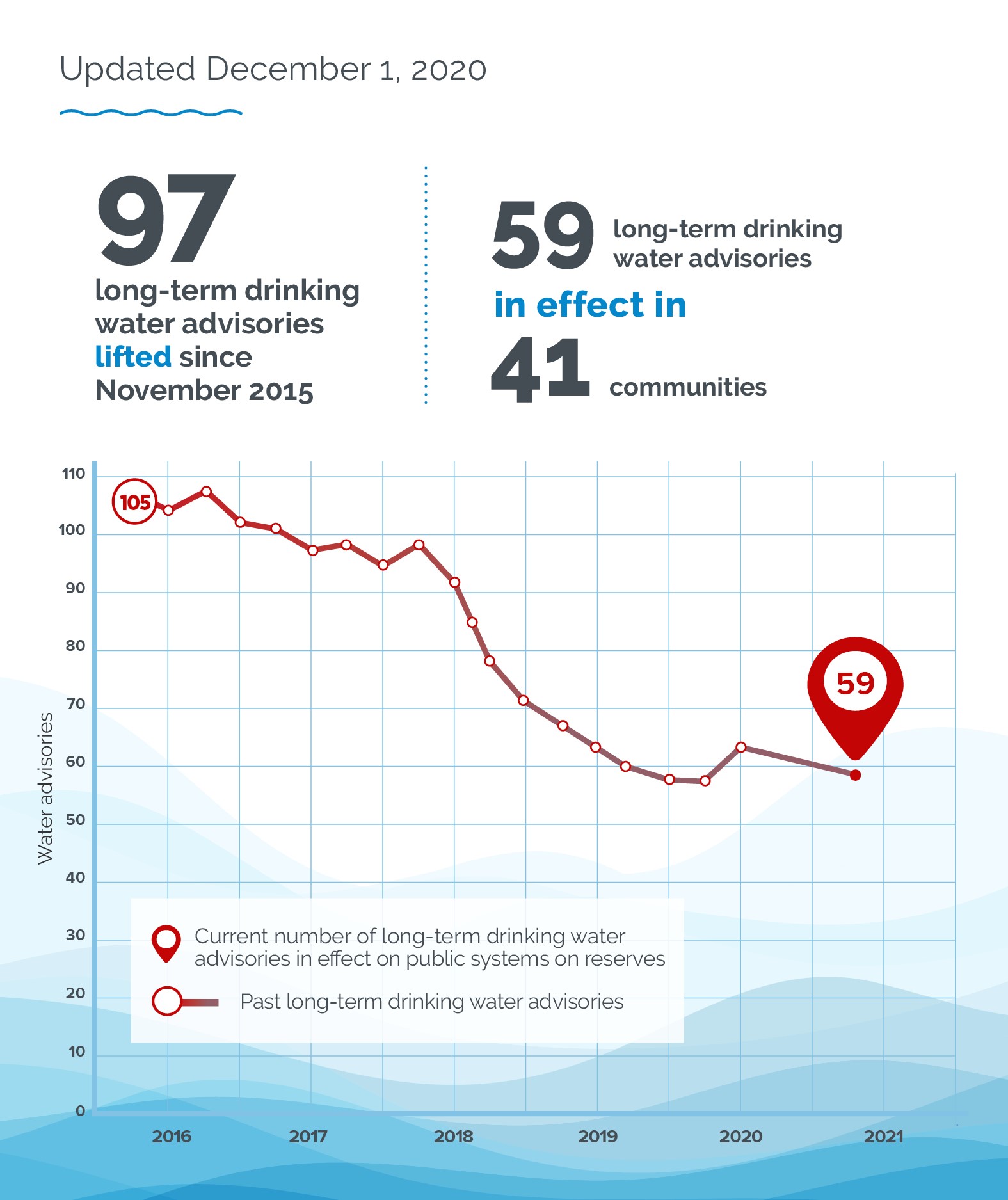
This infographic features a white background with a graphic of blue waves across the bottom third of the page. On the top left, the version date “Updated December 1, 2020” in written grey font underlined by a dark blue waved line. Towards the top third of the infographic, text on the left reads, “97 long-term drinking water advisories lifted since November 2015” in grey font, with the number “97” in large font and the word “lifted’” in blue font. To the right, text reads “59 long-term drinking water advisories in effect in 41 communities” where the numbers are in large font and the words “in effect in” is written in blue text. For the bottom two-thirds of the infographic, there is a large line graph. The vertical axis is labelled with water advisories (ranging from 0 to 110) and the horizontal axis is labelled with years (ranging from 2016 to 2021). In the graph, a red line tracks downwards, from left to right. At the top left of the graph is (around 2015 horizontally) the number 105 in red font a white circle. On the bottom right of the graph (around 2021 horizontally) is the number 59 in a red pinpoint icon. In the bottom left hand side of the graph, a legend depicts that the red pinpoint icon is the “current number of long-term drinking water advisories in effect on public systems on reserves” and that each point on the line graph is “past long-term drinking water advisories.”